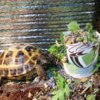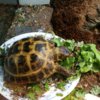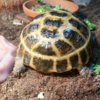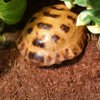HI, I don't post on the forums too often but this thread caught my eye and I just finished reading all ten pages. I'd always been curious on applying oil or moisturizers to shells, I work with horses where hoof oil is commonly used to combat dryness and I've seen it help my horse's feet in the dry season. I'd never tried it on my tortoises though because of it's UV blocking properties. Granted, the arguments I'd heard against it all implied that the tortoise absorbs most of it's UV through the carapace which apparently is untrue. I use a closed chamber for my two Red Foots which helps keep the ambient humidity up and I try to employ the 'spray them until they drip' method of spritzing their shells with a spray bottle a few times a day. Even with the closed chamber it can be difficult to keep the humidity where I want it (although it's infinitely better then when I was using an open table). When the humidity is right my tort's shells are lovely and glossy but they will get dull and dried out as soon as that humidity drops. I am interested in giving the coconut oil a try.
I did want to contest one thing though, you seem to be pretty adamant that soaking twice a week or less is a dangerously low amount. I would argue that it depends entirely on the tortoise involved. I understand why soaking more often is important for your little one if they so rarely use the water dish available to them but some tortoises utilize their dishes a lot. I know my Red Foots are a tropical species, and a desert species may have different natural behaviors, but my guys play in their water dishes all the time. I typically do a force soak once a week or less because I watch them soak themselves, drink, and generally muck about in the water ever single day. I often give them fresh water at lunch time only to have it become a muddy poopy mess by dinner and need to scrub it out again. Forced soaks four times a week could be the right amount for some individuals, but others might not need it quite so often. Heck, earlier this year I ran into the issue of my girl Tortellini sleeping all night in her water dish. I'd rearranged the enclosure and had the dish too close to her mercury vapor bulb, she was treating it as her own personal hot tub and I was starting to get concerned of the possibility of shell rot. I moved it a few inches further from the light and she went back to her usual routine without issue.
Anyway, I do want to give the coconut oil a try. Maybe it will decrease the number of spray bottle mistings we do.
First, I should probably clarify that this is loose framework for an idea. I think its all about personal judgement as well as species of tortoise you have and there daily behaviors. I mean i have a desert species kept under high powered lamps for proper heat, on an open table top that really struggles to maintain humidity, althugh my fight with humidity is now better since i got a handy dandy high-pressure spray bottle. No more tigger finger haha. I also dont see him drink his water too often. So me needing to soak him every other day is really necessary. If you see your little ones always in water then force soaking 4x a week like i said is for sure way to much.
A tortoise hot tub i love it. Please post your observations on here if you get the chance, the more data the better.










